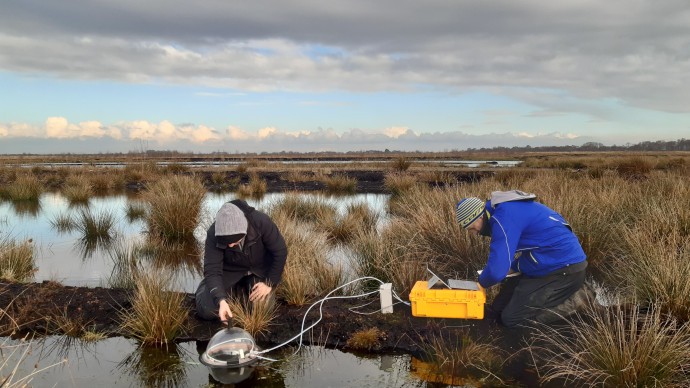
Our leading sustainability research mission
Our research underpins the shift to more sustainable development the world must make — from developing cleaner fuels to protecting vulnerable wildlife and environments.
About our research mission
We are living in a climate and biodiversity emergency. Without rapid advances in technology and more sustainable societies, we will face catastrophic global consequences.
Our internationally recognised researchers are developing the knowledge to make this innovation possible. They work closely with business and public sector bodies to drive sustainability in technology, practice and policy.
Our research strengths include:
- energy storage and conversion technologies, including the use of cleaner fuels such as hydrogen
- aviation’s impact on climate change and routes to sustainability
- using technology for sustainable transformations
- species conservation
- adapting to climate change and becoming more resilient to its effects
- nature-based solutions to environmental problems
- the circular economy
The project explores the ways in which we can learn from and with children and young people in the pursuit of future treescapes that are both socially and environmentally just. Central to this learning is the commitment to attending to minoritized voices, experiences and worldviews that are often overlooked in conversations around treescapes in the UK.
Kate Pahl
Professor of Arts and Literacy
The project explores the ways in which we can learn from and with children and young people in the pursuit of future treescapes that are both socially and environmentally just. Central to this learning is the commitment to attending to minoritized voices, experiences and worldviews that are often overlooked in conversations around treescapes in the UK.
Kate Pahl
Professor of Arts and Literacy
Featured research projects
-
Care-peat
Go to research -
![Ground crew getting a jet plane ready for take off at an international airport]()
Reducing airport carbon emissions
Go to research -
![Two floating windmills being transported to a floating offshore wind farm]()
Extreme loading on floating wind turbines
Go to research -
![An aircraft mechanic inspecting and checking a jet engine in a hangar at an airport.]()
Reducing emissions from aviation
Go to research -
![Waves crashing over coastal defences at Porthleven in Cornwall during Storm Imogen]()
Protection from rising seas and severe storms
Go to research -
![A mobile phone being held while taking an image of a field]()
Edge-AI mobile app for crop disease detection
Go to research -
![A drone hovering above a field of crops]()
Crop disease diagnosis using drones
Go to research -
![Train arriving at a coastal station as a wave breaks over the tracks]()
Protecting coastlines from wind-blown waves
Go to research -
![A view of the rooftops in city centre Manchester at night]()
Air pollution monitoring and modelling
Go to research -
![St. Peter's Square]()
Adapting cities for climate resilience
Go to research -
![American Airlines plane approaching to London Heathrow airport, low above housing estate.]()
Aviation Noise Impact Management
Go to research -
![Recently cleared forest land in Paragominas, northern Brazil]()
Biodiversity and climate in tropical forests
Go to research -
![A microfluidic device used in the dating fossil samples]()
Calculating the age of older fossils
Go to research -
![Researchers in Sierra Leone taking readings in a forest]()
Building capacity to monitor forests
Go to research -
![A technician using a soldering iron to repair a desktop computer]()
Circular economy network
Go to research -
![Researchers taking measurements from a peat bog in the Peak District]()
Enabling peatland recovery
Go to research -
![Carbon Literacy]()
Pioneering carbon literacy training
Go to research -
![Researchers on the island of Java looking for birds in the mountain forest]()
Protecting Java’s montane wildlife
Go to research -
![A young wearing a face mask stood alone in the haze of foggy city]()
Rethinking Healthy City post-COVID-19
Go to research -
![]()
Smart flood protection
Go to research -
![A seal with long whiskers sat on the edge of an artificial pool]()
Touch sensing in mammals
Go to research -
![Traffic on a street overlaid with digital monitoring marks]()
Urban street mobility and air pollution
Go to research -
![A yellow frog sat on a green leaf]()
Electrochemical sensors for fungal pathogens
Go to research
Manchester Met enables intellectually challenging academic work to thrive. It actively facilitates and promotes interdisciplinary research and allows me to develop to my full potential.
Professor Craig Banks
Manchester Met enables intellectually challenging academic work to thrive. It actively facilitates and promotes interdisciplinary research and allows me to develop to my full potential.
Professor Craig Banks
Research groups
-
![A researcher in a lab coat using a machine to treat chemical]()
Catalysis
Find out more -
![An artist's impression of a graphene nanoparticle]()
Electrochemistry
Find out more -
![A bus made by Scania that can run off bio gas being showcased at a trade fair]()
Low carbon fuels and transportation
Find out more -
![Manchester Met researcher observing a rhino]()
Species biology and conservation
Find out more -
![delete me]()
Sustainable futures
Find out more -
![Workers separating paper and plastic on a conveyor belt in a recycling facility]()
Waste 2 Resource Innovation Network
Go to research group -
![The Earth from space]()
Circular Economy Network
Go to the Circular Economy Network -
![Nanoparticles seen under a microscope]()
Nanotechnology
Find out more -
![Offshore wind turbines and breaking waves]()
Mathematical modelling and flow analysis
Find out more -
![A watering hole in an otherwise arid desert]()
Environmental change and adaptation
Find out more -
![A long billed bird with a crest peaking out of a hiding place]()
Ornithology
Go to research group -
![Large group of estate agent boards outside a housing development]()
The Centre for Policy Modelling
Go to research group -
![Sit with us]()
Mobilities in Art and Performance
Go to research group



































